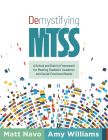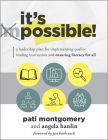
MTSS for Reading Improvement ![BESTSELLER]()
A Leader’s Tool Kit for Schoolwide Success
Transform schoolwide reading achievement through systematic implementation of the science of reading within an MTSS framework. This comprehensive guide provides over 50 practical tools that help leaders engineer robust support systems across all tiers, creating lasting improvements that drive reading success.
Experience the convenience of eBooks! Access your eBooks anytime, anywhere on any desktop, Android, or iOS device through VitalSource. eBook purchases are limited to one eBook per title, per account. Please visit our FAQ for more information.
Reading science in action: an MTSS tool kit
Transform your school’s reading outcomes through systematic implementation of the science of reading within a multitiered system of supports framework. This comprehensive guide provides over 50 practical tools that help leaders engineer robust support systems across all tiers. Move beyond individual interventions to create lasting, system-level improvements. This book is perfect for school leaders ready to bridge research and practice to achieve reading success for all students.
K–12 school leaders and administrators can use this book to:
- Engineer sustainable, systemwide reading improvement through MTSS
- Implement the science of reading at every tier of instruction
- Build effective team structures that drive lasting change
- Transform assessment data into actionable improvement plans
- Create cohesive support systems that benefit all readers
Related Topics
LiteracyResponse to InterventionSchool Improvement
Additional Information
“I highly recommend MTSS for Reading Improvement. As I read this book, I pictured MTSS team members taking critical action steps: carefully examining reading data for all students, determining gaps in schoolwide reading performance, analyzing current curriculum and instructional practices, and implementing a powerful Tier 1 schoolwide reading program while never departing from data-driven decision making. With this book as your guide, you will undoubtedly experience schoolwide reading success.”
“Built on the foundational belief that every student can learn given the right conditions, MTSS for Reading Improvement takes the layered nuances of building a robust, sustainable system of improvement at the district, school, and grade-team levels and distills the complex work into attainable steps. Brown and Stollar provide clear, research-based guidance that is both practical and actionable. From the reflective questions that open each chapter to the real-world scenarios that allow the reader to envision application in their setting, every process is outlined and includes straightforward steps and considerations to complete the work efficiently. The appendices are full of concise, ready-to-use checklists, tools, data protocols, and agendas that support the work of every team, from grade level to district level. I recommend this book to support every stage of MTSS implementation, from beginning steps to fine-tuning a system already in place. This book should be required reading for anyone tasked with improving reading outcomes for all students. It is the immunization that prevents school systems from failing in their mission to support every student.”
“MTSS for Reading Improvement is a must-read for school, district, and state leaders who want to systematically improve reading outcomes for students. Brown and Stollar bridge the research on the science of reading and MTSS to draw a compelling picture of the path to continuous improvement. Moreover, their experiences working with leaders across the educational system are evident throughout the book. Any leader navigating the change required to improve reading outcomes within their MTSS will benefit from the practical strategies and tools the authors have refined in collaboration with real schools doing the work.”
“In the rush to improve reading outcomes, schools often look for the perfect program, but even the best programs fail without an effective system behind them. Brown and Stollar bring MTSS to life through meeting templates, helpful charts, and real-world examples. Unsure if your school is over-testing? Their assessment audit will tell you. Struggling with unfocused team meetings? Their ready-to-use agendas keep discussions productive. Confused about what to do with all that data? Their simple protocols guide analysis and action. Leaders will find exactly what they need inside MTSS for Reading Improvement: practical tools that take the guesswork out of implementation. Every leader serious about improving reading outcomes needs this book.”
“This book masterfully connects the framework of MTSS with the science of reading, providing a powerful toolkit for school leaders committed to enhancing student literacy; it is exactly what is needed right now in schools. By emphasizing the importance of data-driven decision making, continuous improvement, and tiered instruction, the authors highlight how MTSS can transform schools into environments where every educator and student thrives. The resource offers practical tools, including meeting protocols and reflection questions, to empower leaders to align instructional strategies with research and improve systems tailored to the needs of their staff, students, and communities. With a focus on real examples of effective implementation and decades of lessons learned, this book serves as an indispensable guide to navigating the complexities of educational systems and fostering a culture of collaboration and equity.
“What truly sets this book apart is its relentless pursuit of making reading improvement stick through actionable insights and a dedication to removing barriers that impede progress. Brown and Stollar have crafted a resource that celebrates the expertise of classroom teachers while empowering leaders to create the conditions necessary for effective reading instruction and intervention. Recognizing the need for context-specific implementation, the book bridges the gap between research and practice, offering a balanced approach to MTSS for Reading Improvement that fits the unique challenges of each school. This guide is an essential read for educators and leaders striving to advance literacy outcomes and transform the lives of their students through meaningful, systemwide improvement.”
“This book is packed with accurate information explained clearly and paired with actionable steps. Busy school leaders will appreciate its efficiency. It gets straight to the point, providing the essential information and directives needed to lead your school in building a sustainable and effective system of reading support.”
“There is no shortage of resources to help educators understand the science of reading and how it can be translated into instruction. This book takes it a step further, providing a much-needed road map for educators to make the science of reading a reality in their school by using an MTSS framework. The activities and agendas provided are fantastic and will serve as useful tools for teams of educators to reflect on their current systems and translate the book into meaningful action that benefits all students.”
“This is perhaps the best-balanced resource available for implementing the science of reading within an MTSS framework. It answers most of the what and how questions, while offering just enough of the why to be both persuasive and actionable. The tone is approachable, and the structure mirrors effective instructional practice, with advance organizer questions, reflection prompts, and real-world application scenarios. It will be invaluable to leaders, schools, and districts looking to elevate their reading instruction.
“Nearly forty years ago, when we began shaping what is now known as MTSS, we understood the problems but lacked the tools to solve them. Brown and Stollar have spent decades helping to build and scale those tools. One of this book’s great strengths is the wealth of implementation supports—developed, tested, and refined through real-world use. Whether you’re just starting or well down the road, this work offers practical insight and ready-to-use protocols grounded in deep, lived experience. It speaks with a voice that invites, supports, and empowers.
“There’s a refreshing clarity throughout. The content is rich but never overwhelming. The details are precise and purposeful. Each chapter begins with thoughtful, actionable questions and is filled with scenarios that make the work tangible. The message is consistent and compelling: prevention outperforms remediation, and precision—not complexity—is what moves systems forward.”
When can I access my eBook? Your eBook will be accessible through VitalSource once your payment has been processed.*
*When using a check or purchase order, the order submitted online will not be processed until Solution Tree receives the check or a copy of the signed official purchase order. Your purchase order must note payment terms of net 30 days. We cannot process purchase orders that do not note these payment terms. Please submit all payments to [email protected].
How do I access my eBook?
To access your eBook:
- Create a free VitalSource account by visiting VitalSource.com. If you already have a VitalSource account, please log in to your account.
- Paste the redemption code that Solution Tree will email you in the “Redemption Code” field on VitalSource.com/Redeem. (Note: You can also access your redemption code within your Solution Tree account under the “eBook” section.)
- Click “Redeem.”
- Enjoy! Once your code is redeemed, your book will be added to your VitalSource Bookshelf and can be read anytime, anywhere.
What are the technical requirements for accessing the eBook? A VitalSource account is required. To sign up for your free account, please visit VitalSource.com.
What if I have trouble accessing my eBook? Please contact VitalSource by emailing [email protected] or by utilizing their Live Chat feature.
What are the shipping and handling costs? There are no shipping or handling costs associated with eBooks. For paperback and hardcover book purchases, standard shipping costs apply. Please visit the Product Orders page for more information on shipping and handling costs.
Can I purchase multiple copies of the same eBook? Bulk orders are not currently available through the website. Website purchases are limited to one eBook per title, per account. If you want to order multiple copies of an eBook, please contact customer support at [email protected].
What if I need to request a refund on my eBook order? RETURN POLICY: We are unable to accept returns or cancel previously placed eBook orders.




